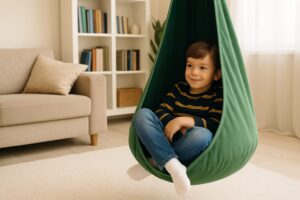Pod Sensory Swings: Picks, Benefits, and Setup Tips
Pod swings create a cozy, enclosed retreat that can help kids and adults relax, self-regulate, and enjoy gentle vestibular input. They are popular for autism, ADHD, and sensory processing needs at home, classrooms, and clinics.
- Ideal for calm retreats and sensory regulation
- Typical capacity: about 150-300 lb (check your model)
- Setups: ceiling mount, doorway bar, or free-standing frame
What is a pod swing?
A pod, cocoon, or hammock chair is a single-point hanging seat with fabric walls that wrap around the user. The enclosed shape reduces visual distraction and can provide a gentle, secure feeling while you add slow, rhythmic movement.
Benefits of pod swings
- Enclosing fabric can dampen visual input for a calm, cocoon feel.
- Short, predictable movement sessions may support regulation and attention.
- Versatile: indoor ceiling mount, doorway bar, or portable frames.
- Pairs well with other vestibular supports in a sensory space.
Pros
- Compact, single-point mount fits small spaces.
- Cozy, enclosed feel can boost sense of security.
- Portable and simple to clean for most models.
Cons
- Not for rough play or high-amplitude swinging.
- Requires proper mounting or a rated frame.
- Some users prefer open styles such as platform swings.
Setup choices
- Ceiling mount: Anchor into a joist with rated hardware. See the step-by-step mounting guide.
- Doorway bar: Quick, removable option for renters. See no-mount options.
- Free-standing frame: Most flexible when you have floor space; great for multipurpose rooms.
Simple routines and activities
- Calm-and-read: 2-5 minutes of slow, linear front-to-back swings while reading or listening to music.
- Peekaboo cocoon: briefly close the fabric, then open on a count to practice start-stop control.
- Transition helper: short routine before homework or bedtime to support regulation.
- Pairing: follow swinging with heavy work like wall push-ups or carrying a weighted lap pad.
Top pod swing picks
Cozy Cotton Pod Swing
My quick take: Super compact cocoon for small rooms and calm-down corners. Great starter when you want an easy, all-in kit for younger users.
- Material: Cotton
- Maximum Weight Recommendation: 100 lb
- Includes: all hardware; adjustable nylon belt
- Mounting hardware: expansion bolt (for concrete) and wood screws (for wooden joists)
- Single-point hang; indoor or covered outdoor friendly
Pod Swing with 360 deg Swivel and Adjustable Height
My quick take: The 360 deg swivel keeps fabric from twisting; setup is fast once you have picked your joist.
- Material: Cotton
- Maximum Weight Recommendation: 176 lb
- Includes: expansion screws, wood screws, adjustable straps, 360 deg swivel ring, clear instructions
- Install claim: Easy 15-minute installation; upgraded four-hole hardware
- Comfort: two PVC inflatable cushions
Large Cushioned Pod Swing (HiChrote)
My quick take: Generously sized pod that does not feel cramped. Better for big kids, teens, and many adults.
- Material: Polyester
- Maximum Weight Recommendation: 300 lb
- Includes: hanging hardware and detailed height instructions
- Accessories: daisy chains, carabiners, U-hooks, stainless steel hang kit (x2 expansion screws, x2 self-tapping screws)
- Single-point mount; indoor or covered outdoor use
Affiliate notice: As an Amazon Associate, we earn from qualifying purchases.

